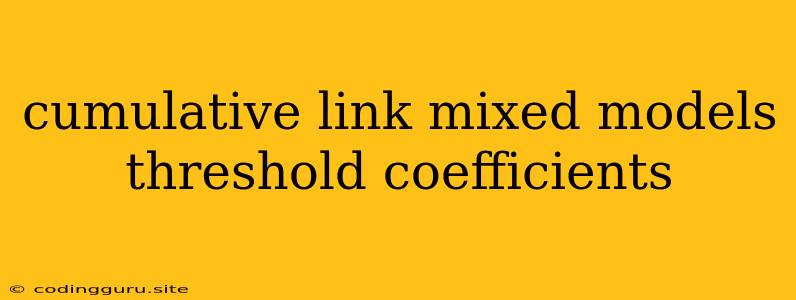Understanding and Interpreting Cumulative Link Mixed Models with Threshold Coefficients
Cumulative link mixed models (CLMMs) are a powerful tool for analyzing ordinal data, which are data that can be ordered but not necessarily measured on a continuous scale. This type of data is common in many fields, such as healthcare, social sciences, and education. For instance, a survey might ask respondents to rate their satisfaction with a product on a scale from "very dissatisfied" to "very satisfied."
One crucial aspect of CLMMs is the use of threshold coefficients. These coefficients determine the "cut-off" points between different categories of the ordinal response variable. By understanding these thresholds, researchers can gain valuable insights into the relationships between predictors and the likelihood of falling into specific categories.
What are Threshold Coefficients?
Imagine a survey asking people to rate their pain level on a scale of 1 to 5, where 1 represents "no pain" and 5 represents "extreme pain." In a CLMM, threshold coefficients define the points where the probability of experiencing a higher pain level increases. For example, one threshold coefficient might correspond to the point where the probability of experiencing at least a "mild pain" (level 2) becomes greater than the probability of experiencing "no pain" (level 1).
How are Threshold Coefficients Interpreted?
Threshold coefficients are typically expressed as "log odds". This means that a positive coefficient indicates that the probability of experiencing a higher level of the response variable increases with an increase in the corresponding predictor. Conversely, a negative coefficient suggests a decrease in probability.
The magnitude of the threshold coefficient reflects the strength of the association between the predictor and the likelihood of being in a higher category. Larger coefficients suggest a stronger relationship.
Example: Interpreting Threshold Coefficients in a CLMM
Let's consider a study investigating the relationship between stress levels and perceived health status. The health status variable is measured on a four-point scale: "Excellent," "Good," "Fair," and "Poor." The study uses a CLMM with stress level as the predictor and health status as the response variable.
The following table presents the estimated threshold coefficients:
| Threshold | Coefficient |
|---|---|
| Good vs. Excellent | 0.50 |
| Fair vs. Good | 1.25 |
| Poor vs. Fair | 2.00 |
Interpretation:
- Good vs. Excellent: A one-unit increase in stress level is associated with a 0.50 log-odds increase in the probability of reporting "Good" health status compared to "Excellent" health status.
- Fair vs. Good: A one-unit increase in stress level is associated with a 1.25 log-odds increase in the probability of reporting "Fair" health status compared to "Good" health status.
- Poor vs. Fair: A one-unit increase in stress level is associated with a 2.00 log-odds increase in the probability of reporting "Poor" health status compared to "Fair" health status.
From these coefficients, we can infer:
- The effect of stress level on the likelihood of reporting a lower health status category is stronger at higher levels of health status.
- The effect is most pronounced when comparing "Poor" vs. "Fair" health status, indicating a significant impact of stress level on the likelihood of reporting the lowest health category.
Tips for Interpreting Threshold Coefficients
- Focus on the direction of the coefficient: A positive coefficient suggests an increase in the probability of a higher category, while a negative coefficient indicates a decrease.
- Consider the magnitude of the coefficient: Larger coefficients imply a stronger effect of the predictor.
- Compare coefficients across different thresholds: This can help reveal changes in the effect of the predictor across different levels of the response variable.
- Use visualization tools: Plotting the probability of each response category as a function of the predictor can help visualize the effect of threshold coefficients.
Conclusion
Threshold coefficients provide valuable insights into the relationships between predictors and different categories within an ordinal response variable. By understanding these coefficients, researchers can effectively analyze the effects of predictors on the likelihood of experiencing different levels of the outcome. Through careful interpretation and visualization, CLMMs with threshold coefficients can contribute significantly to our understanding of complex phenomena involving ordinal data.
